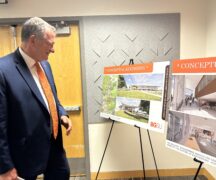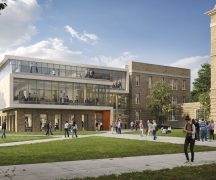By DAVID DUPONT
BG Independent News
After spending the last few summers bringing new life to the two original buildings on the Bowling Green State University campus, next summer will see two 1950s vintage structures bite the dust.
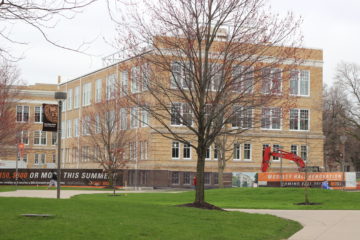
Moseley Hall
Steve Krakoff, the vice president for capital planning and campus operations, told Faculty Senate Tuesday that the work tearing down West Hall and the neighboring Family and Consumer Sciences building will begin as soon as classes are over. That work will be completed by the time students return to campus. The demolition will require some work on Founders Hall which is connected to the two doomed structures.
Both buildings were rendered redundant by upgrades that have been Krakoff’s focus in the past years.
West Hall was no longer needed once the former South Hall was renovated and expanded into the Kuhlin Center, which houses the School for Media and Communication Renovations to the Health and Human Services Building after the Falcon Health Center opened, and to Eppler, meant there was no longer a need for Family and Consumer Sciences.
But the campus isn’t just on the eve of destruction this summer. Work on the renovation of University and Moseley halls will be completed, so those 100-year-old structures will open in the fall semester.
Krakoff said those who taught in those buildings in the past will find the new space “unrecognizable.” He expects “a lot of positive shock.”
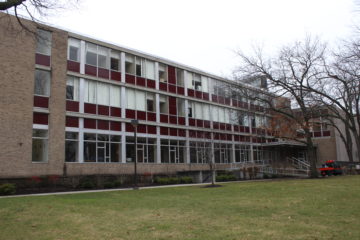
West Hall
While upgrading the buildings, the university has maintained distinctive architectural features.
And less dramatic, but essential, projects will take place across campus.
Krakoff said that the conversion of all BGSU’s 145 classrooms into active learning spaces is continuing. University Hall will have six, and eight classrooms will be converted into seven active learning spaces in the Education Building.
After this summer 90 classrooms will have been upgraded. He expects those renovations should be completed within three years. Few if any university this size will then have the same kind of up-to-date classroom inventory.
Those changes have created expectations. Joseph Chao of Computer Science wondered when work on Hayes Hall would begin.
John Fischer, vice provost of academic affairs, said Hayes was one of the next buildings.
Provost Rodney Rogers said student expectations are also up.
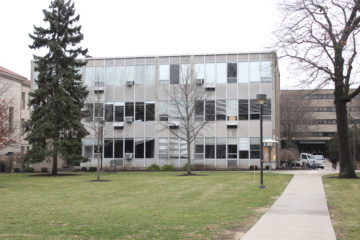
Family and Consumer Sciences
“As we move toward more active learning classrooms, it’s amazing how student expectations begin to shift,” he said. “So they begin to assume that there will be new and active ways to engage with the learning process.”
While the space is upgraded, the challenge for faculty is “to think about ways to engage students in the space,” he said. “Some students have expressed concern that there’s this new space but still a tradition approach.”
Mariana Mitova, of the School of Family and Consumer Sciences, noted that her program, apparel merchandising and product development, has “relocated to beautiful space.”
While she understands some of the frustration with the moves – “we’re creatures of habit” – she said that “in the end what we get is beautiful facilities.”
After the summer, buildings around campus will also have upgraded electrical systems, Krakoff said. This is part of the ongoing work to catch up on “deferred” infrastructure projects. Many of the electrical systems on campus date back to the 1950s, he said, which is not conducive to energy conservation.
The biggest project on the horizon is the renovation of Hanna Hall into the Maurer Center, the new home for the College of Business Administration. Construction is expected to begin in 2018, he said, with the center scheduled to open in 2020. That will complete the $500-million second phase of the university’s master plan.
As part of that transformation, the Gish Theatre will move to the existing theater in the student union. Some of the memorabilia at the Gish will also go to the union, with other material going to Jerome Library.
(It has also been reported that the Women’s Center will move to the second floor of Math Sciences.)
Rebecca Green, from the School of Art, noted that the plans showed the parking lot now to the east of Hanna and University halls would be eliminated.
Krakoff said that was the case. There is “sufficient parking” in that area, he said.
That area will be the entry to the university’s “academic core,” and a parking lot would not be the most attractive feature.
Jim Evans, of geology, also asked about the plans for the Forrest-Creason Golf Course site when the course closes after this season and whether the university will seek input from faculty and others.
Krakoff said his office will be seeking advice on how to transition that land from a golf course to a more natural environment.
Also on tap is a new roof for Business Administration, which will continue to be used for classrooms after the Maurer Center opens, and duct work in the Moore Musical Arts Center.
Krakoff said at one point his office had more than 300 projects underway. All are important whether it’s renovating an office or gutting and rehabbing a 100-year-old legacy building.



